Maps of heavy metals in Wellington’s soils show impacts of urbanisation
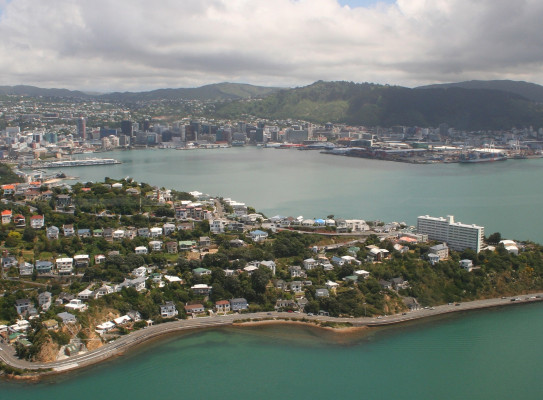
A new study from GNS Science marks a significant step in the assessment of environmental contamination in Aotearoa New Zealand’s capital.
The Urban Geochemical Atlas of Wellington provides the first baseline of the concentrations of elements in the near-surface soils of the Wellington region, highlighting where human activities have increased levels of heavy metals and other elements.
Researchers from GNS Science have measured the concentrations of 65 different elements in the soils across the Wellington region, excluding most of the Wairarapa and Kāpiti Coast. Soil samples were taken from more than 150 sites for the study, from a mixture of public and privately-owned land. The results are presented in a series of maps. They can be used to help identify potential localised health and environmental impacts of contaminants, and to target mitigation and remediation efforts.
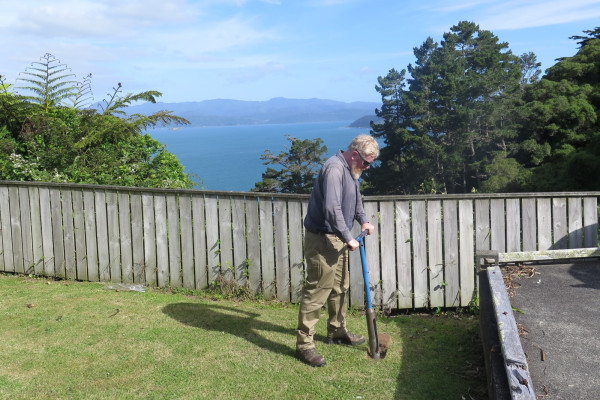
Several of the elements included in the atlas are metals that, in certain concentrations, can be hazardous to human health, including arsenic, cadmium, chromium, copper, mercury, nickel, lead, and zinc. The occurrence of these metals in the soils across the country typically varies due to differences in underlying rock types, environmental conditions and human influence. However, Regine Morgenstern, GNS Science geologist, says that as the geology in the study region is relatively uniform, it’s not a significant factor influencing the elevated levels of these heavy metals found in some Wellington soils.

The data reveals human influences on soil chemistry across the area, and this can also be clearly seen in the maps.
"For example, the map for lead shows the highest concentrations across much of the more densely developed areas, particularly around Wellington Harbour and the Hutt Valley, where a lot of old housing stock exists," says Morgenstern.
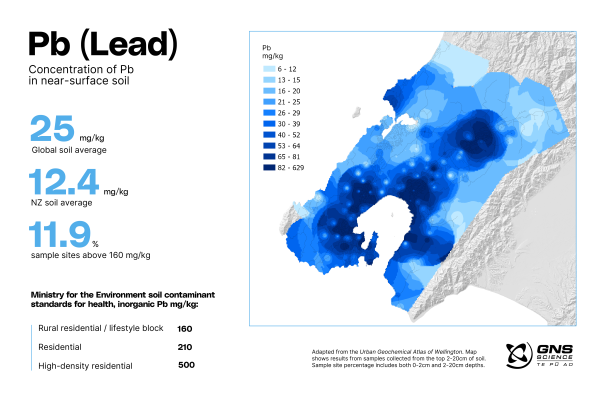
Morgenstern says that it is not unexpected to find elevated levels of heavy metals in highly populated areas.
"This is common in cities worldwide, with possible sources including pollution from industrial processes, leaded petrol from our past, disposal of fossil fuel residues and household waste, and the deterioration and removal of lead-containing paints from older houses."
The Ministry for the Environment (MfE) issues New Zealand’s soil contaminant standards for health. The standards set out the acceptable concentrations of heavy metals in soil, categorised by land use, with the most restrictive category assigned for rural residential or lifestyle blocks.
The study found some sample sites that exceeded the most restrictive thresholds for arsenic, lead and cadmium, with several samples exceeding standards set for high-density residential land use. Median lead values in Wellington soil are significantly higher than those found in New Zealand soils in general, but are below median values observed in urban soils in Dunedin City.
The sample spacings and interpolation technique used to construct the maps provides relatively low spatial resolution, but offers a good guide for where more detailed study at higher spatial resolution may be warranted.

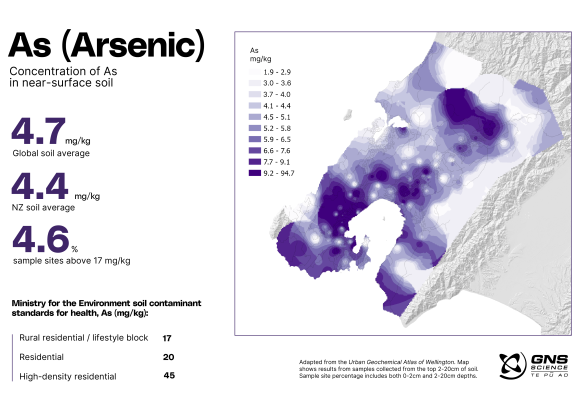
Morgenstern said that although residents may be concerned if they learn their home is located within an area shown in the atlas to have elevated heavy metals, the maps cannot be used to pinpoint element concentrations for individual properties.
"We know that even within one property, concentrations can vary. Lead levels might be higher closer to a house where there has been an accumulation from leaded paint, and then lower in the vegetable garden. The estimated element concentrations are indicative only and how representative the estimates are for any site can only be confirmed with further sampling and analysis."
Anyone interested in finding out more about the levels of heavy metals in their backyard can send a sample to the free soil-testing service Soilsafe Aotearoa. GNS Science helped to establish this service, which is run by the University of Auckland.
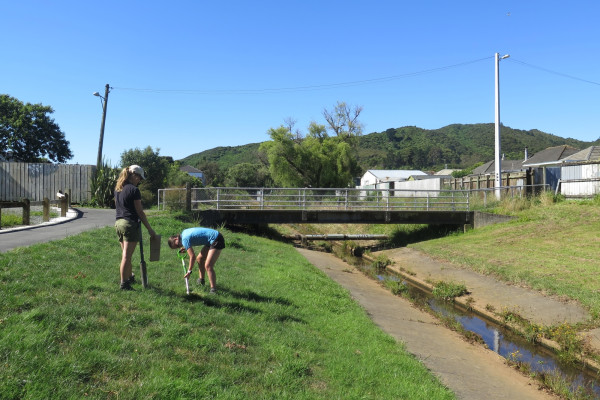
The atlas is the latest publication in GNS Science’s ongoing work mapping geochemical soil variation across Aotearoa New Zealand. It follows the recent release of a national atlas, and other localised studies including Dunedin and Auckland cities, Southland, Nelson-Marlborough and Otago.
GNS Science Environment and Climate Theme Leader, Giuseppe Cortese says these studies are an important addition to the wider work that GNS Science undertakes to quantify the contaminants present in our air, freshwater, ocean and soil, and to understand how these contaminants move through our environment.
It can be confronting to see the impact that human settlement and urbanisation has had on Wellington’s soils, and the heavy metals that have accumulated as a result of our activities.
"The atlas provides important information about the location and concentration of key elements so that we can monitor them, apply remediation measures if necessary, and manage their movement today. The data also offers a starting point from which we can explore and model how these elements may move through our environment in the future. This is particularly important in the Wellington area where projected population increases will result in further urban densification," says Cortese.
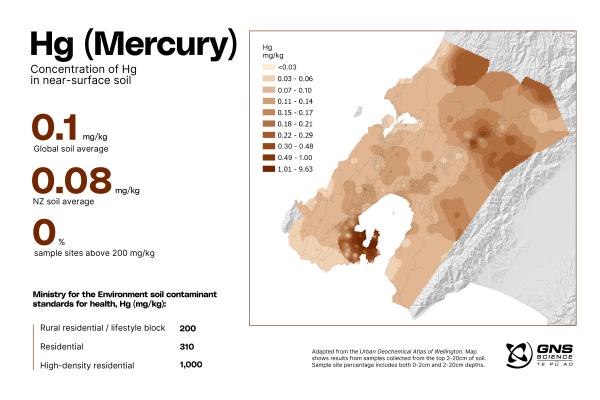
Aerial photo of Wellington city and harbour. Credit: Kyle Bland.
-
Elevated heavy metal results
Heavy metals and metalloids occur naturally in soil, water and food, and many are essential in small quantities for human health. However, some heavy metals are toxic above certain quantities, and subsequently the Ministry for the Environment (MfE) has set guidelines (Soil contaminant standards for health Users Guide) for acceptable levels of these substances in New Zealand soils for a variety of different land uses.
Soil samples were taken from the first 2 cm and 2-20 cm depths at 151 sites for the study, between December 2022 and April 2023.
- Seven sample sites exceeded the most restrictive MfE threshold for arsenic – these were all domestic properties from highly built-up areas in Wellington hill suburbs, Johnsonville, Whitby, central Lower Hutt and an Upper Hutt suburb, with one exceeding the standard set for high-density residential areas.
- 18 sample sites had concentrations of lead greater than the most restrictive MfE threshold, with three exceeding the standard set for high-density residential areas.
- Cadmium hotspots surround Wellington Harbour, and two sample sites exceeded the most restrictive MfE soil contamination standard.
- While Wellington city shows up on the map as a relative hotspot for mercury, all mercury levels were well below the threshold set by MfE.
-
Soil contamination - health information
Known methods of transfer of heavy metals into soil include air pollution from industrial processes and vehicle emissions, long-term application of fertilisers and the deterioration and renovation of lead-containing paints. Despite lead no longer being used in New Zealand petrol and paints, a long-term pollution problem exists because soil fixes lead rapidly and strongly and because many of our old houses still have leaded paint. Heavy metals transfer from our soil to our food and household dust, and can then be ingested.
Soilsafe Aotearoa(external link) is a community science project run by the School of Environment at the University of Auckland. Members of the public can send a sample of their backyard soil for free testing for arsenic, copper, lead and zinc.
Health New Zealand Te Whatu Ora has information about the health impacts of lead(external link), arsenic(external link), and soil contamination(external link).